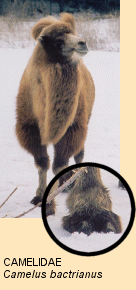 |
Modern day camelids are the only living representatives of the suborder Tylopoda
(from the Greek words tylo, meaning callous, and pous, genitive
podos, meaning foot). The four Recent species are well adapted to
arid environments. A unique wide pad of connective tissue on the base of
the feet provides support on soft, sandy soils. The fossil record of this
subfamily begins in the mid-Eocene deposits of North America (the center
of camelid evolution). The camels radiated out from North America to Eurasia
in the Pliocene, and to South America during the Pleistocene, disappearing
from North America around 10,000 years ago.
The feet of modern camels seemingly defy the definition of "ungulate": the two digits in the feet (III and IV) sit almost flat on the ground (i.e., are digitigrade) as part of a wide pad. Instead of hooves, the distal phalanges bear nails on their upper surface. Nevertheless, the fossil record distinctly shows that camels are ungulates: fossilized camels from the Oligocene have the same two-digit foot structure, but were nearly unguligrade and likely had true hooves. These early camels display one of the characteristic features of Tylopods: the metapodials (foot bones) are fused to form a cannon bone, but the distal ends separate and flare outward, forming a "Y" of bone (the arms of the "Y" lead to the two digits). A general climatic shift to more arid conditions occurred in the Miocene, and was coupled with a secondary development of a digitigrade foot posture. All camelids since the Pliocene have been digitigrade. The position of this family within the order Artiodactyla was formerly confounded by the fact that camelids ruminate (regurgitate and rechew their food) - at was thus assumed that they were more closely related to the ruminants than the Suiformes. However, molecular evidence suggests that this feature evolved independently from the Ruminantia; the stomach of the Camelidae is only three-chambered. All members of this family are renowned for "spitting" when upset, although it is actually stomach contents which are ejected at annoying objects. The upper lip of all members of the Camelidae is split into two finger-like projections which aid in the collection of tough forage. The dental formula is I 1/3, C 1/1, P 2-3/1-2, M 3/3 x 2 = 30-34. There is no gall bladder. Unique among mammals, the red blood cells of the Camelidae are oval in shape. There is no connective skin between the hind legs and the belly, increasing the apparent length of the hind legs. Camelids walk with a "pacing" gait, where both the front and hind legs on one side of the body are moved forward together. The result is that the body weight is shifted from one side to the other, creating a rocking motion - camels are thus often called "ships of the desert". All four species of recent camels have been domesticated. The two domestic forms from South America (the llama and alpaca) were formerly considered as species in their own right; today, they are lumped together with their wild counterparts (the guanaco and vicuña, respectively). While domestic camelids are found in large numbers, the wild species are all listed on the IUCN's Red List. Indeed, the dromedary or Arabian camel (Camelus dromedarius), is now extinct in the wild (although feral populations exist, notably in Australia). |
(From Price, Bininda-Emonds, and Gittleman, 2005)
| Return to Artiodactyla |
Camelus ferus
Lama guanicoe |
or jump to the Camelidae Species List